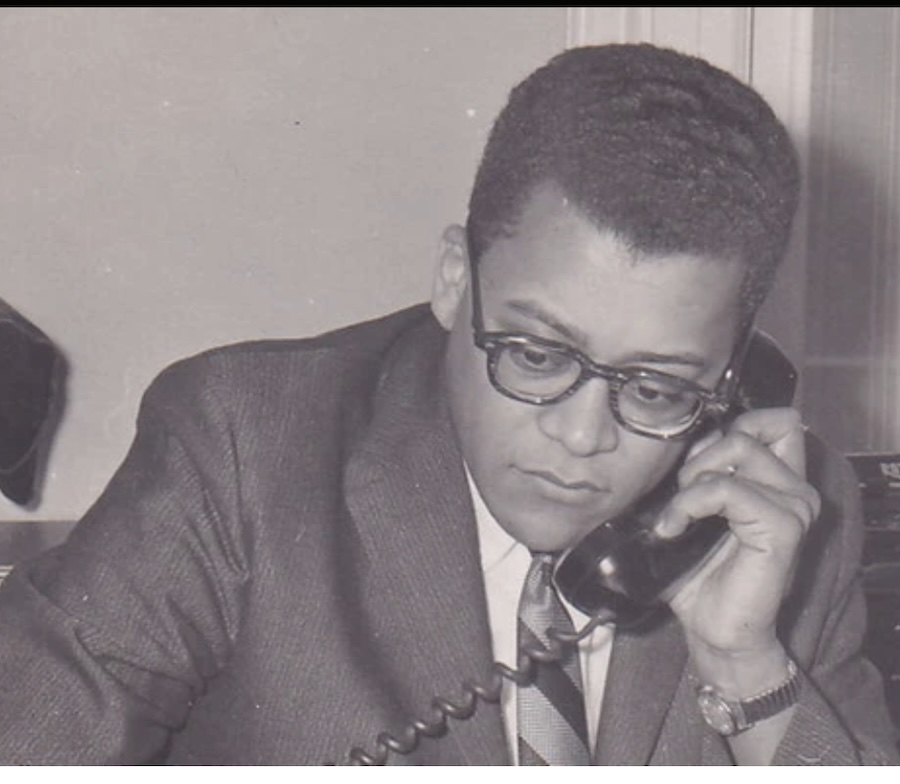FREE FLOW OF INFORMATION .
An article by Ethan Vesely-Flad in Common Dreams (licensed under Creative Commons CC BY-NC-ND 3.0)
Rev. Dr. Martin Luther King, Jr. called him “the leading theorist and strategist of nonviolence in the world.” To Rep. John Lewis, he was “the architect of the nonviolence movement.” Jesse Jackson simply called him “the Teacher.” We at the Fellowship of Reconciliation are blessed to have counted him among our core team of organizers. It is with reverence that we remember his life and time with us.

James Lawson at work with the Fellowship of Reconciliation in 1960. (Photo credit: FOR archives)
Rev. James M. Lawson, Jr., who died Sunday at age 95, was born in Uniontown, Pennsylvania, and moved with his family to Massillon, Ohio, shortly after. As part of a deeply Christian family, James began regularly reading the bible and developed a prophetic and liberatory interpretation of the gospels at an early age. In a 2014 interview published by Fellowship magazine, Lawson told Diane Lefer, “By the end of my high school years, I came to recognize that that whole business – walk the second mile, turn the other cheek, pray for the enemy, see the enemy as a fellow human being – was a resistance movement. It was not an acquiescent affair or a passive affair. I saw it as a place where my own life grew in strength inwardly, and where I had actually seen people changed because I responded with the other cheek. I went the second mile with them.”
While attending Baldwin-Wallace College, Lawson met A.J. Muste, the Fellowship of Reconciliation’s executive secretary, a renowned pacifist and nonviolent direct action strategist. Deeply inspired, Lawson immediately joined the FOR. Graduating college in 1950, as the Cold War grew, Lawson determined that he would refuse the military draft. Instead of Korea, he was sent to prison, where he served 13 months.
In 1953, Lawson accepted an offer from Hislop College in Nagpur, India, to teach and coach athletics, giving him the opportunity to, like FOR members Howard Thurman and Bayard Rustin had done before him, explore the connections between the Indian self-determination movement and the African-American freedom struggle. Lawson spent the next three years on the subcontinent studying Gandhi’s life and the Satyagraha movement. “I combined the methodological analysis of Gandhi with the teachings of Jesus, who concludes that there are no human beings that you can exclude from the grace of God,” Lawson described to Lefer.
(Article continued in the column on the right)
How can we carry forward the work of the great peace and justice activists who went before us?
(Article continued from the column on the left)
Lawson was completing a graduate degree at the Oberlin School of Theology when Dr. Martin Luther King Jr., while visiting the campus, recruited him. King insisted to Lawson that his expertise was needed, not eventually, but immediately! “I mentioned to [King] that while in college I had long wanted to work in the South – especially because of segregation – as a place of work, and that I wanted to do that still,” Lawson told Fellowship magazine editor Richard Deats in 1999. “His response was: ‘Come now! Don’t wait! Don’t put it off too long. We need you NOW!”
When Lawson told A.J. Muste of his decision to move South, Muste quickly offered him a position as FOR’s Southern Field Secretary. Basing himself initially in Nashville, Lawson began working throughout the South, initially with FOR and then the Southern Christian Leadership Conference (SCLC). He focused especially on recruiting and training a generation of nonviolent direct-action activists. Those young people then launched the sit-ins and Freedom Rides and founded the Student Nonviolent Coordinating Committee (SNCC).
In 1965, while representing SCLC on an International FOR delegation to Vietnam, Lawson met Thich Nhat Hanh. This encounter significantly affected Lawson, inspiring him to facilitate a meeting between the Buddhist monk and Dr. King, and ultimately led to King’s dramatic public stance against the U.S. war in Vietnam. Lawson’s profound assessment of U.S. militarism and what he called “plantation capitalism” shaped not only the interweaving of the 1960s civil rights and anti-war struggles but ultimately how our intersectional social movements are shaped today.
In 1974, in Los Angeles, Lawson continued his solidarity with impoverished low-wage workers. He founded Clergy and Laity United for Economic Justice to enlist faith communities in this struggle and pushed direct action campaigns for which he was arrested “more [times] than [during] all his work in the South.”
Lawson spent his last decades both working within peace circles while offering critiques that their movements devoted too much of their focus outside U.S. borders. He believed that true change could only come from within. “Only by engaging in domestic issues and molding a domestic coalition for justice can we confront the militarization of our land,” he argued to Lefer in 2014. “We must confront that here – not over there.”
Whether prophetically interpreting the scriptures, challenging America’s original sin with the fierce power of nonviolent direct action, or strategically connecting with other monumental peace leaders, Lawson’s commitment to social justice was relentless and unwavering. We at the Fellowship of Reconciliation are blessed to have worked with and been mentored by him. As we continue to confront the injustices of our times, we know that Lawson’s spirit is walking beside us.
(Editor’s note: You may find a more detailed biography on the website of The Nation, but we have no budget to pay for reproduction.)
– – – – – –
If you wish to make a comment on this article, you may write to coordinator@cpnn-world.org with the title “Comment on (name of article)” and we will put your comment on line. Because of the flood of spam, we have discontinued the direct application of comments.